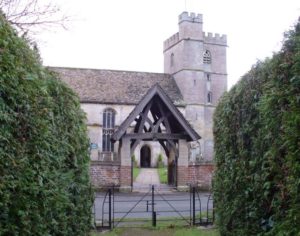At some point, we’ve all walked past or through the lych gate (or lytch gate) of our village church, St Michael and All Angels. Many older churches have one of these, usually in the form of a covered entrance to the church grounds – it marks the division between consecrated and unconsecrated ground. In older days, it was the place where the bearers sheltered with the coffin before a burial. Often, the priest would meet the funeral congregation and carry out the first part of the burial ceremony under the lych gate roof.
The first lych gates are thought to have appeared in the 7th century, although many have been rebuilt on several occasions. Others are somewhat later in date, sometimes built as a bequest by a wealthy local resident. The gate at St Michael’s is an example of this and was dedicated in September 1955. It was presented to the church by Mrs Dorothy J Dunn (and her son Michael) in memory of her late husband, Major Claude de Lisle Bush of Eastington Park. Claude has cropped up in several previous ECN articles – for example, he kept a pack of Bassett Hounds at the Park. Educated at Clifton College and commissioned a 2nd Lieutenant in 1912, Claude saw action in the First World War. He was wounded at Ypres in 1914 but survived his injuries. Following the war, he was attached to the Kings African Rifles and served for some time in Mombasa, Kenya. But once again, he was sent to war, and in January 1941, he was killed while fighting with the Gloucestershire Regiment.
 From the outset, the intention had been to build the new lych gate using local craftsmen and with materials sourced locally. The architect (Mr C D Carus-Wilson) designed the new gate using brick, stone, oak and tiles. The sand-faced bricks were from the Stonehouse brickworks, and the stone from a quarry at Minchinhampton. But when it came to the Oak needed, there was a problem. It was hoped to use Oak felled on the Eastington Park estate, but it seems that nothing available was big enough. As a result, coppice-grown Oak was cut by Miss C Cole of Pontshill in the Forest of Dean. Around one and a half tons of this was then transported to Frampton-on-Severn where Mr W B Wood and his three sons cut and shaped it to meet the architect’s plans. The gate’s roof was made of 2½ tons of Cotswold stone tiles sourced from a redundant building in Wotton-under-Edge, with the stone ridge tiles coming from an old shed near Haresfield. Tom Bailey from Little Haresfield undertook the actual tiling work. Metalwork for the gate was produced by blacksmith Mr B Wyer in his forge at Whitminster. Ships nails were used to construct the oak frame and attach the stone tiles, these coming from Mr Davis’s dry dock on the Gloucester-Berkeley Canal at Saul. It’s remarkable how many individual craftsmen were involved in the project, and just how much local history is wrapped up in this apparently simple structure.
From the outset, the intention had been to build the new lych gate using local craftsmen and with materials sourced locally. The architect (Mr C D Carus-Wilson) designed the new gate using brick, stone, oak and tiles. The sand-faced bricks were from the Stonehouse brickworks, and the stone from a quarry at Minchinhampton. But when it came to the Oak needed, there was a problem. It was hoped to use Oak felled on the Eastington Park estate, but it seems that nothing available was big enough. As a result, coppice-grown Oak was cut by Miss C Cole of Pontshill in the Forest of Dean. Around one and a half tons of this was then transported to Frampton-on-Severn where Mr W B Wood and his three sons cut and shaped it to meet the architect’s plans. The gate’s roof was made of 2½ tons of Cotswold stone tiles sourced from a redundant building in Wotton-under-Edge, with the stone ridge tiles coming from an old shed near Haresfield. Tom Bailey from Little Haresfield undertook the actual tiling work. Metalwork for the gate was produced by blacksmith Mr B Wyer in his forge at Whitminster. Ships nails were used to construct the oak frame and attach the stone tiles, these coming from Mr Davis’s dry dock on the Gloucester-Berkeley Canal at Saul. It’s remarkable how many individual craftsmen were involved in the project, and just how much local history is wrapped up in this apparently simple structure.
The new lych gate was dedicated on Sunday the 25th September, a date chosen as it was the nearest Sunday to the feast of St Michaels and All angels, the church’s patron saint. The procession was headed by the Bishop of Tewkesbury, the Rt. Rev. Edward Henderson. He was followed by the Eastington choir, dressed in blue and white robes.


While we’re on the subject – it’s i nteresting to compare the two views of the church. The early engraving was produced by a Mr Nichols and dates from 1795. The main body of the church and the tower hasn’t changed much, at least visually. However, it now boasts various additions made in 1832 when the vestry was added, and in 1851 when mill owner Charles Hooper paid for a restoration and the lengthening of the nave.
nteresting to compare the two views of the church. The early engraving was produced by a Mr Nichols and dates from 1795. The main body of the church and the tower hasn’t changed much, at least visually. However, it now boasts various additions made in 1832 when the vestry was added, and in 1851 when mill owner Charles Hooper paid for a restoration and the lengthening of the nave.
– and note the yew tree!! Ed.
Steve Mills.

You must be logged in to post a comment.